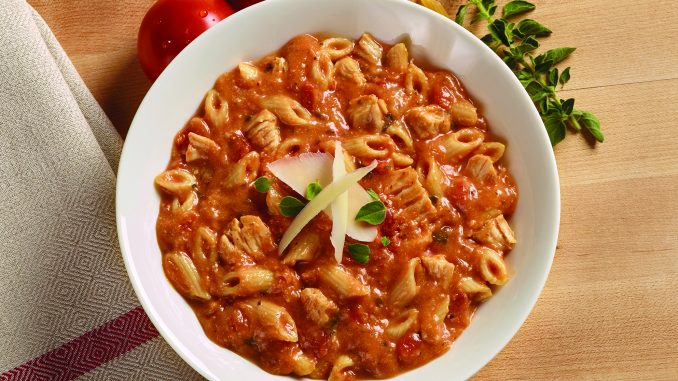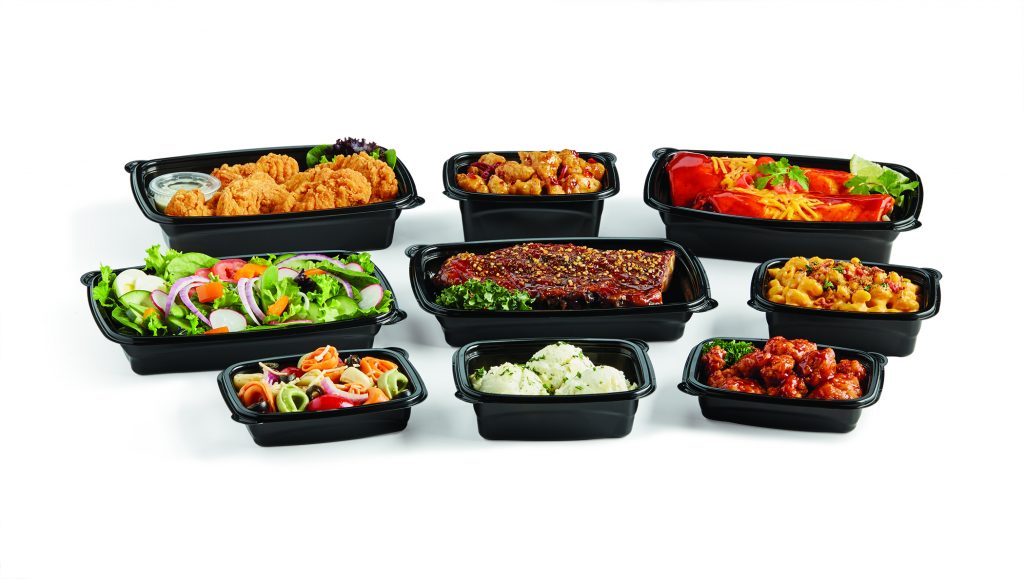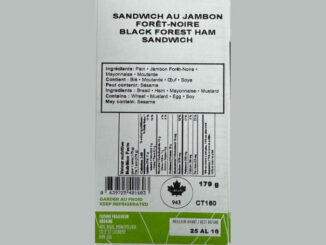
Prepared food has been a juggernaut for supermarket delis in recent years. In 2019, prepared meals were a top selling category, generating close to $15 billion, according to New York-based Statistica. During the 52 weeks ending Aug. 9, 2020, chicken had a 41.4% category share of deli-prepared entrées in grocery stores in the United States. Conversely, vegetarian entrées had a category share of 2.4% that year. Sushi had the next highest category share at close to 25%. Potatoes were the most popular side dish in 2019.
When the pandemic hit the U.S., deli departments were forced to be nimble when it came to this category. In response, food bars were replaced with more extensive grab-and-go sections in stores. Yet prepared foods continues to be prominent in retail, despite the recent challenges.
“Prepared foods will continue to be strong,” says Jim Gawronski, director of sales and marketing, Garden Fresh Foods, Milwaukee, WI. “In March, everything came to a standstill. Prior to Memorial Day, all hot bars and salad bars were shut down. There was a paradigm shift, with 50% to 60% of this business behind the glass in 2019, then reverting to prepackaged with Covid.”
Garden Fresh Foods is focusing on its meal kits, which are prepared in delis kitchens.
With more consumers eating at home, they are limiting their grocery store trips, yet have bigger orders and are more apt to utilize curbside pickup and delivery.
“This unexpected shake-up creates challenges but offers new opportunities, particularly for deli counters that are able to innovate in ways that address these consumer shopping behaviors and health and safety concerns,” says Corey Wilde, vice president of new business development at Charlotte, NC-based Hissho Sushi.
Ready-to-serve deli salads, pre-sliced meats and cheeses, and ready-to-heat-and-serve sides offer both familiarity and time-savings, says Nathan Roe, senior manager, deli strategy and customer marketing, Reser’s Fine Foods, based in Beaverton, OR.
Because of Covid and the shift in consumer shopping behavior, many delis have shifted all or a portion of their bulk, freshly-prepared salads to prepacked items to reduce labor and adjust to the shift in shopping behaviors.
Pressures on the entire supply chain, from graphic design to packaging to ingredient vendors, have impacted typical product development timelines for new items as well as existing product flow, Roe explains.
As a result, manufacturers are having issues meeting demand and are focusing on meeting the inventory levels in prepackaged formats that are now most prevalent.
“While we don’t know how things will continue to evolve, we expect that, long term, deli cases will return to having a wide variety of ready-to-serve choices that consumers are looking for, with an emphasis on value,” says Roe. “It’s been nothing short of impressive to see how quickly delis have responded to the shift in buying behaviors, labor constraints, and additional safety measures all at once.”
Trending Foods
Prepared food trends are typically regional but overall today’s consumers are seeking comfort foods, international flavor profiles and nutritious options.
“What we’re seeing now is a continued push for packaged prepared foods, whether done in store or by a manufacturer,” says Bob Sewall, vice president, sales and marketing, Blount Fine Foods, Fall River, MA. “People are getting cooking fatigue at home so prepared meals and grab-and-go options are doing great.”
Blount Fine Foods’ best sellers include its 16-ounce Family Kitchen Bowls, such as beef stroganoff, chicken Parmesan and chicken marsala as well as its packaged soups.
“It’s mostly comfort foods people are moving towards, no question, because it’s what they’re familiar with,” says Sewall. “With money being tight, people want to spend money on what they know.”
Before and after Covid, consumers have been trying to figure out their dinner plan at 3:30 or 4 the same day, and that’s where supermarket deli prepared food programs come in.
“Even singles and Millennials are seeking meal solutions,” says Carl H. Cappelli, senior vice president of sales and business development for Don’s Prepared Foods, based in Schwenksville, PA. “Folks will continue ordering food online this year, and prepared foods will remain on trend. Also, as retailers figure out what to do with food bars in the deli, prepackaged prepared meals and sides can utilize that space. People are seeking globally-inspired meal solutions that taste good and are healthy and well prepared.”
It’s convenience and variety that are driving growth within supermarket delis.
“Consumers are especially responding to innovative entrées, appetizers and prepared foods, while at the same time seeking authenticity, nutrition and responsibly-sourced ingredients,” says Wilde at Hissho Sushi.
The company’s retail partners and their customers want more convenience, innovation and variety in prepared foods. Shoppers want options that not only allow them to customize what they crave—but also feel good about it.
Hissho’s biggest successes of 2020 zeroed in on these growing trends. One example is its recent partnership with Walmart at their flagship store in Rogers, AR. In August, the company opened a Hissho Sushi & Craft Beer Bar at this store, which offers a sit-down restaurant experience with an expanded menu and features a new line of hot appetizers, desserts, coffee and a selection of local craft beer and wine.
“This unique, one-of-a-kind concept caters to consumer preferences, such as variety, sustainability and convenience,” says Wilde. “It has also allowed us to tap into another growing trend: digitally-enabled ordering and delivery. For our Rogers customers, we have launched our new Hissho Sushi app, where consumers have direct access to our menu and can order on their own time while earning rewards through our loyalty program.”
Reser’s chefs and R&D teams utilize new flavors and ingredients to offer a high cadence of innovation.
“Sometimes we focus on a single herb or spice that’s trending, such as dill, parsley or cilantro or a primary ingredient, like deviled eggs, to give a quick cue to the consumer on what to expect,” Roe says. “Appealing ingredients, such as wild rice and pepitas combined with creative techniques, such as roasting, spiralizing or caramelizing, are some of the new and delicious flavor combos we’ve introduced that are trending.”
Deli prepared foods are predicated on great taste and rewarding experiences at home, so healthful options and variety are key.
“It’s about the full solution, not just products, when putting together a meal,” says Larry Montuori, vice president of sales, Nuovo Pasta Productions, LTD., Stratford, CT. “Meal kits are hot, but they have to be high quality. We’re finding that consumers prefer to gather various components and put them together.”
Along with ethnic flavors, Mediterranean ingredients like olives, olive oil and roasted vegetables remain popular. Also, Indian foods and ingredients, especially turmeric, which has health benefits, are on trend.
“In general, people want to experience interesting flavor profiles,” says Montuori.
In response to COVID-19, Madison, WI-based Placon has seen an increase in tamper-evident packaging and packaged foods within the deli space.
“Retailers are closing down salad bars and self-serve areas and moving towards prepared portions of salad toppings, cold cuts and other deli items that are being put into tamper-evident packaging or in some cases sealed bags,” says Derek Skogen, Placon’s senior product manager. “Consumers want to see the food they are buying, which is why using our post-consumer recycled PET material EcoStar is a great solution for retailers from a visibility/clarity standpoint and the fact that it is made using post-consumer recycled PET bottles and thermoforms that can be recycled after use.”
Placon continues to see retailers invest heavily in prepared meals for the deli sections.
“People are looking for convenience and what better way to do that than by purchasing a meal kit or prepared meal that can be microwaved or simply re-heated in the oven upon arriving at home?” Skogen says.

The Programs
The quintessential potato salad, mac and cheese and cole slaw are staples in supermarket delis, with protein anchors remaining tuna, chicken and egg salad. Yet, the tide is turning to include more international fare.
As shoppers look to the deli for takeout, they’re often looking for wholesome, authentic options. To address this, Hissho has joined forces with fresh Asian comfort food innovator Nona Lim to unveil a collection of authentic Asian meals.
“Given the times and the need for trusted comfort foods, we are finding our potato salads—both original and deviled egg varieties—are staples in supermarket delis,” says Roe at Reser’s. “There is something quite comforting in the familiar tastes and flavors of our deli salads, and we’ve heard from consumers that taste, comfort and convenience during these challenging times are qualities they truly appreciate and value. Other ready-to-heat-and-serve sides and proteins that simplify meal prep continue to be staples.”
“Grain salads are up 26% over a year ago, and five to 10 years ago grains weren’t a staple,” says Cappelli at Don’s Prepared Foods. “The evolution of chains is occurring; while some parts of the country go toward traditional items, many are looking for healthier options without sacrificing flavor and taste.”
In terms of prepared food packaging, Placon works with a variety of grocery retailers that have invested heavily in the prepared meals and tamper-evident segments to better help protect and give peace of mind to the customer.
“Our food packaging product line offers our CrystalSeal reFresh Tamper-Evident line that, upon being closed, uses a unique tab closure system where upon being opened the lid will slightly tear away from the base,” says Skogen. “This allows a customer to see or know if a product has been tampered with prior to purchase. A vast majority of our tamper-evident containers can be film sealed to add a second layer of protection should retailers determine that is necessary for a specific product. When it comes to prepared meals, our HomeFresh Entrée line offers retailers a variety of options.”
What’s New
Despite 2020’s challenges, prepared food manufacturers have debuted a number of new products in the last year.
Blount Fine Foods’ newest items are high-end seafood soups, including Clamjack as well as its broccoli and cheddar mac and cheese under the Panera brand.
With environmental consciousness remaining top of mind for consumers and retailers in 2021, Hissho will focus on premium products and ingredients that reinforce sustainability and quality.
Reser’s launch of its Jalapeño Cheddar Pasta Salad has been one of its biggest successes.
“This creamy salad with big noodles and a little kick, plus the curious addition of jalapeño peppers as an ingredient in a deli case, has had our customers asking for even more innovation in creamy-heat salad concepts,” says Roe.
Due to the continued popularity of Mexican fare and pasta, Garden Fresh Foods focused its innovation on those segments. It introduced prepared meal kits, such as pasta fresca in a 5 ½-pound kit as well as Mexicana rice and chicken in a 12-ounce heat-and-serve tray.
“People are gravitating toward comfort foods, like our classic cheese ravioli, duck confit ravioli, lobster ravioli and sausage ravioli,” says Montuori at Nuovo Pasta Productions. “Also, plant-based meat alternatives are popular, such as our spinach asiago and garlic.”
Don’s Prepared Foods recently launched its five Power Meals, including Chicken Pesto Pasta Bowl, Unwrapped Grilled Chicken Burrito Bowl, Honey Sriracha Chicken Bowl, the plant-based Korean BBQ-Style ChickN Bowl and Mexican-Style Chorizo & Rice Bowl.

Marketing & Merchandising
Proper marketing and merchandising work in creating a prepared food destination in the deli. Yet, the displays of today may not resemble those of past years.
“Retailers can utilize refrigerated salad bars for packaged meals and soups,” says Sewall at Blount Fine Foods. “It’s about using the floor space better to gain more attention for packaged meals.”
Retailers have been putting prepared meals behind the glass ready to go or by bunkers next to the deli salad case to bring customers into the department.
“Point of sale material, including electronic methods and signage, works well,” says Gawronski at Garden Fresh Foods. “Merchandising needs to be viable and visible rather than just waiting for customers to go to the deli case.”
Hissho turns to targeted promotions that rewards shoppers to turn them into repeat customers.
“It’s also about adapting to lifestyle trends; social media is an important platform that we use to bring news and awareness of our sushi and concepts to a wider audience,” Wilde says. “We’ve seen remarkable success in partnering with influencers across the country who help us expand our reach and build new relationships.”
Reser’s is working closely with retail partners on a variety of in-store and online programs in response to anticipated changes.
“From meal deals to targeted coupon promotions to virtual sampling, many tactics that have been around for years are now core to meeting consumers where they are most comfortable browsing and buying,” says Roe. “We know that 2021 won’t look like 2020, and retailers have already modified what and how they sell, both of which have shaken up the deli salad category.”
As consumers have shifted to purchasing more packaged salads, Reser’s understands the critical decisions retailers must make to staff and manage their delis efficiently.
“Assortments may change more often, category reviews may be less frequent, margin pressure may increase,” Roe says. “By simultaneously measuring the pulse of consumers and having growth-oriented conversations with our retailer partners, Reser’s intends to continue influencing and driving category growth.”
With the current climate, retailers will continue to invest and focus heavily on tamper-evident packaging (containers, bags, etc.) to ensure products are safe and secure from the manufacturing facility to the end-user.
“Prepared meal kits and on-the-go convenience will continue to drive purchase decisions for consumers,” says Placon’s Skogen. “Today, the majority or families are not taking more than one hour to make a dinner for the family. Brands and retailers will need to create a nutritional meal option to engage with consumers, as they don’t want just the traditional TV dinner that some may find has a bland taste.”
Wilde at Hissho Sushi sees tremendous growth ahead for prepared foods in supermarket delis, but continual innovation and reinvention is vital, as it may not be the traditional in-store visits like in the past.
“Shoppers are turning to digital ordering like never before, and we don’t see that slowing down, even after the pandemic has ended,” says Wilde.
Sewall at Blount Fine Foods predicts the country will eventually get back to business as usual with hot food bars and soup bars.
“The shift towards consumer packaged food in delis is bringing new customers into the department,” Sewall says. “In the long term, we will see that consumer packaged goods has forced customers into buying packaged fresh product as opposed to frozen. It opened up a nice category that developed in deli. In a strange way, Covid hurt hot bar sales but invigorated CPG sales. Once we get a balance of hot foods and CPG foods, the delis will be stronger than ever. I don’t see consumers shifting away from buying fresh foods, since they are still looking for convenience.” DB



